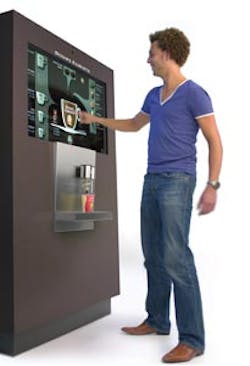The vending industry is experiencing its most difficult time ever. And while operators struggle, technology continues its march forward, setting the foundation for future where automated retailing plays a major role in the way consumers live.
All segments of the vending industry — operators and suppliers alike — struggle to sustain sales and profits, while a parallel industry — kiosks and digital signage — evolves, creating new opportunities to sell a greater variety of products and services in a more sensory intensive manner.
As Automatic Merchandiser has reported on these innovations in recent years, the magazine’s editorial team has wrestled with the question of what relevance kiosks and digital signage has to traditional vending.
I believe that the most recent Self Service Expo in New York City was especially instructive in answering this question.
During the expo, several exhibits presented technology that provides new ways for vending machines to give shoppers promotional deals and offers. By incorporating some of the technology that the kiosk and digital signage industry is using, vending machines can provide more information to answer shoppers’ questions and, at the same time, speed up transactions.
To date, kiosks and digital signs have been deployed outside of the traditional vending industry. These devices have become very sophisticated — with excellent graphic capabilities and fast, responsive customer interfaces. Getting vending, kiosks and digital signage to work together is a significant challenge.
The good news is that it’s already being done. There are market tests in progress in the U.S. and in Europe with cold drink machines, snack machines and hot beverage machines.
It will take time. And it will take money — serious investments — for the companies involved to test and refine these exciting new developments.
But for the traditional vending industry to become relevant to the retail foodservice and refreshment consumer, these investments have to be made.
The young consumers who grew up with iPhones, digital video entertainment, iPods and wi-fi are becoming the new work force. Just observe people in shopping malls, transportation terminals, lounges and waiting rooms.
THREE CONCEPTS ALREADY IN THE FIELD
Here are three important examples of the blending of vending equipment and kiosks and digital signs:
1) The Coca-Cola interactive vending machine from Coca-Cola, Sapient and Samsung.
2) The diji-touch snack vending machine from Kraft Vending & OCS, Samsung and Crane Merchandising Systems.
3) The Douwe Egberts BeMoved coffee vending machine from Sara Lee International.
The keynote speakers at the Self Service Expo in New York City were from companies succeeding in “monetizing” kiosks and digital signage by delivering products with vending transactions. “Monetizing” refers to getting financial results (i.e., sales value) out of an existing application — in this case a kiosk or digital sign.
One of these keynote speakers was Keith Berman, senior marketing manager for strategic partnerships at Coca-Cola Co. In his presentation, Berman explained how the company transforms simple transactions into brand interactions.
Coca-Cola has 150 Coke interactive vending machines deployed at shopping malls around the country. The company is focusing on changing the way it works with teens.
The interactive vending machine resulted in the soft drink vending machine being moved from bathroom hallways to front and center in the mall atrium. Improving where the machines were placed generated more sales and much more brand exposure.
The primary objective was to shift from “shopping transaction” to “brand interaction,” Berman said. Through the use of sight and sound, shoppers can be attracted to approach the machine.
Next, they interact with the touchscreen. Three screen sections offer the following:
1) a continuous series of brand featured messages;
2) an interactive touchscreen showing the products being offered and the ability to see and interact with the package (360-degree rotation), plus nutritional information; and
3) a promotional screen to tie-in with Coca-Cola brand messages or tie-in with their partners.
There is a “5-digit difference in cost versus a traditional soft drink vending machine,” according to Berman. “This machine has not been engineered (yet) to identify cost savings,” he noted. “What is being tested now is the marketing opportunity.”
The machine does not “pay out” (deliver its most important benefit) based on driving incremental sales, even though Berman claims sales increased by 35 percent versus a control group of machines. But it is a winner when it comes to advertising impact. It delivers brand impressions at about 20 percent of the cost of traditional teen media.
Berman also noted that they are only using about 20 to 30 percent of the machine’s capabilities. Future applications will allow for ring-tone downloads, Bluetooth connections, opportunities to win prizes and other promotional tools.
Coca-Cola recognizes that the interface has to be easy to use. Even for tech-savvy teens, going from screen to screen has to be intuitive.
New products will be part of the “news” delivered with the machine. Berman noted that their newest product packaging — aluminum bottles — have been merchandised to the teen audience.
THE KRAFT DIJI TOUCH MACHINE
The diji-touch machine from Kraft Vending & OCS, Crane Merchandising Systems and Samsung also features an embedded networked computer and a 46-inch Samsung LCD touch-screen panel. By tapping icons on the screen, a customer can get a 360-degree look at any snack, find out its nutritional information, or its ingredients.
A market test was recently launched, and the goal is to have a proposition for operators at the National Automatic Merchandising Association OneShow in Chicago.
This machine was a big hit at the last NAMA show. The companies involved were pleasantly surprised by the enthusiastic response from many vending operators. Even while the industry is struggling through a recession and operators aren’t in a buying mood, many operators seem to recognize that the industry has to bring more value to the consumer, and they are glad that some of its traditional manufacturers have taken initiative.
FROM EUROPE COMES ‘BEMOVED’
Our next example hails from across the pond, where Sara Lee International has released information on its Douwe Egberts coffee vending machine. This exciting new vending machine, “BeMoved,” is truly a concept machine at this time, according to Hotske Wesselius, Sara Lee International senior brand manager.
The current model is for demonstration only — with no payment system capabilities. Douwe Egberts is taking a long-term view of this machine.
The concept is really different from what we’ve come to expect from hot beverage vending machines — even from the very latest hot beverage machines. Wesselius said, “BeMoved is about enriching the coffee moment and experience. It also allows the possibility of offering a large set of choices in a very user-friendly way. ”
TECHNOLOGY, DESIGN AND INTERACTION
The BeMoved concept is innovative in the areas of technology, design and interaction. The machine can be operated by means of a large touchscreen, or by activating a motion sensitive camera. Users can choose from a selection of eye-catching interfaces, such as “drag-and-drop” (drag the ingredients into the cup), “explore” (discover your coffee in the “living” tree), and “picture it.”
“BeMoved provides consumers with Douwe Egberts’ liquid coffee. The liquid coffee is customized by each consumer when he or she interacts with the machine and creates their perfect cup of coffee,” according to Wesselius. “The machine has the ability to create many different types of coffee, like a latte macchiato, cappuccino and espresso — all in combination with different flavors, such as vanilla, chocolate, cinnamon, etc.”
It’s about delivering a better shopping experience, allowing shoppers to customize their own perfect cup of coffee. This is how to compete with the coffee shops.
There is an important lesson here. It doesn’t matter if your business is vending, onsite foodservice or OCS. What does matter is innovation! It’s all about constantly improving what you offer and how you present it to your customers.
Today’s shoppers expect service providers to consistently upgrade their service. In our channel, that’s the products we sell and the equipment we use to serve and sell what we offer. You may be thinking it doesn’t apply to your business. But it does. And it is even more of an issue for younger people — who will be your customers for the next 20 to 30 years.
Young people are always looking for the latest device and then the newest application for their highly sophisticated iPhone, BlackBerry, Google Android, etc. At the same time, they expect that your business is looking out for their interests — by finding and deploying the latest and greatest equipment in vending, foodservice and OCS.
We have a simple business. We sell food and beverages. We’ve been doing it essentially the same way for 20 to 30 years — maybe more. What’s happening is that our customers are changing. They’re younger. They’re much more high-tech than their parents. They’re very fickle. If you don’t satisfy their needs — they’re gone. What you sell can be purchased elsewhere — in a more interesting place.
We’ll see you in Chicago — at the NAMA OneShow. You’ll learn more there at my education session — “The Vending Store of the Future.”
For more information, contact:
Coca-Cola Co., 800-438-2653, www.thecoca-colacompany.com
Kraft Vending & OCS, 800-852-9393, http://kraftvendingocs.com
Sara Lee International, 800-261-4754, www.saraleefoodservice.com
Talking Points
The kiosk and digital signage industry is developing interactive capabilities that vending machines can use.
A handful of firms are incorporating these sensory-intensive tools in vending and testing them in the field.
The vending consumer is changing as the technology savvy younger generation expects a new and more satisfying vending experience.
About the Author

Paul Schlossberg
Contributing Editor
Paul Schlossberg is the president of D/FW Consulting, which helps clients merchandise and market products in impulse intense selling environments, such as vending, foodservice and convenience stores. He can be reached at [email protected] or 972-877-2972; www.DFWConsulting.net.
Most recently he has begun writing a bimonthly online column titled "Sell More Stuff" featured on VendingMarketWatch.com.
